Role of microglial IKKbeta in kainic acid-induced hippocampal neuronal cell death
- PMID: 18819987
- PMCID: PMC2577806
- DOI: 10.1093/brain/awn230
Role of microglial IKKbeta in kainic acid-induced hippocampal neuronal cell death
Abstract
Microglial cells are activated during excitotoxin-induced neurodegeneration. However, the in vivo role of microglia activation in neurodegeneration has not yet been fully elucidated. To this end, we used Ikkbeta conditional knockout mice (LysM-Cre/Ikkbeta(F/F)) in which the Ikkbeta gene is specifically deleted in cells of myeloid lineage, including microglia, in the CNS. This deletion reduced IkappaB kinase (IKK) activity in cultured primary microglia by up to 40% compared with wild-type (Ikkbeta(F/F)), and lipopolysaccharide-induced proinflammatory gene expression was also compromised. Kainic acid (KA)-induced hippocampal neuronal cell death was reduced by 30% in LysM-Cre/Ikkbeta(F/F) mice compared with wild-type mice. Reduced neuronal cell death was accompanied by decreased KA-induced glial cell activation and subsequent expression of proinflammatory genes such as tumour necrosis factor (TNF)-alpha and interleukin (IL)-1beta. Similarly, neurons in organotypic hippocampal slice cultures (OHSCs) from LysM-Cre/Ikkbeta(F/F) mouse brain were less susceptible to KA-induced excitotoxicity compared with wild-type OHSCs, due in part to decreased TNF-alpha and IL-1beta expression. Based on these data, we concluded that IKK/nuclear factor-kappaB dependent microglia activation contributes to KA-induced hippocampal neuronal cell death in vivo through induction of inflammatory mediators.
Figures
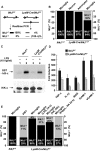
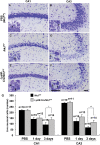
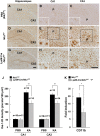


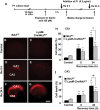


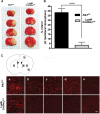
Similar articles
-
Microglial Toll-like receptor 2 contributes to kainic acid-induced glial activation and hippocampal neuronal cell death.J Biol Chem. 2010 Dec 10;285(50):39447-57. doi: 10.1074/jbc.M110.132522. Epub 2010 Oct 5. J Biol Chem. 2010. PMID: 20923777 Free PMC article.
-
Fundamentally different roles of neuronal TNF receptors in CNS pathology: TNFR1 and IKKβ promote microglial responses and tissue injury in demyelination while TNFR2 protects against excitotoxicity in mice.J Neuroinflammation. 2021 Sep 26;18(1):222. doi: 10.1186/s12974-021-02200-4. J Neuroinflammation. 2021. PMID: 34565380 Free PMC article.
-
Kainic acid-induced neurodegeneration and activation of inflammatory processes in organotypic hippocampal slice cultures: treatment with cyclooxygenase-2 inhibitor does not prevent neuronal death.Neuropharmacology. 2011 Jun;60(7-8):1116-25. doi: 10.1016/j.neuropharm.2010.09.024. Epub 2010 Oct 7. Neuropharmacology. 2011. PMID: 20932983
-
Ghrelin attenuates kainic acid-induced neuronal cell death in the mouse hippocampus.J Endocrinol. 2010 Jun;205(3):263-70. doi: 10.1677/JOE-10-0040. Epub 2010 Mar 29. J Endocrinol. 2010. PMID: 20351014
-
Regulation and function of IKK and IKK-related kinases.Sci STKE. 2006 Oct 17;2006(357):re13. doi: 10.1126/stke.3572006re13. Sci STKE. 2006. PMID: 17047224 Review.
Cited by
-
The Isotropic Fractionator as a Tool for Quantitative Analysis in Central Nervous System Diseases.Front Cell Neurosci. 2016 Aug 5;10:190. doi: 10.3389/fncel.2016.00190. eCollection 2016. Front Cell Neurosci. 2016. PMID: 27547177 Free PMC article.
-
TLR2-induced astrocyte MMP9 activation compromises the blood brain barrier and exacerbates intracerebral hemorrhage in animal models.Mol Brain. 2015 Apr 10;8:23. doi: 10.1186/s13041-015-0116-z. Mol Brain. 2015. PMID: 25879213 Free PMC article.
-
SARS-CoV-2 spike protein induces cognitive deficit and anxiety-like behavior in mouse via non-cell autonomous hippocampal neuronal death.Sci Rep. 2022 Mar 31;12(1):5496. doi: 10.1038/s41598-022-09410-7. Sci Rep. 2022. PMID: 35361832 Free PMC article.
-
The SHH/Gli pathway is reactivated in reactive glia and drives proliferation in response to neurodegeneration-induced lesions.Glia. 2014 Oct;62(10):1595-607. doi: 10.1002/glia.22702. Epub 2014 Jun 4. Glia. 2014. PMID: 24895267 Free PMC article.
-
TSPO deficiency exacerbates acute brain damage after intracerebral hemorrhage in male mice.J Cereb Blood Flow Metab. 2025 May 15:271678X251340509. doi: 10.1177/0271678X251340509. Online ahead of print. J Cereb Blood Flow Metab. 2025. PMID: 40370317 Free PMC article.
References
-
- Acarin L, Gonzalez B, Castellano B. STAT3 and NFkappaB activation precedes glial reactivity in the excitotoxically injured young cortex but not in the corresponding distal thalamic nuclei. J Neuropathol Exp Neurol. 2000;59:151–63. - PubMed
-
- Andersson PB, Perry VH, Gordon S. The CNS acute inflammatory response to excitotoxic neuronal cell death. Immunol Lett. 1991a;30:177–81. - PubMed
-
- Andersson PB, Perry VH, Gordon S. The kinetics and morphological characteristics of the macrophage-microglial response to kainic acid-induced neuronal degeneration. Neuroscience. 1991b;42:201–14. - PubMed
-
- Barone FC, Feuerstein GZ. Inflammatory mediators and stroke: new opportunities for novel therapeutics. J Cereb Blood Flow Metab. 1999;19:819–34. - PubMed
-
- Block ML, Zecca L, Hong JS. Microglia-mediated neurotoxicity: uncovering the molecular mechanisms. Nat Rev Neurosci. 2007;8:57–69. - PubMed
Publication types
MeSH terms
Substances
Grants and funding
LinkOut - more resources
Full Text Sources
Other Literature Sources
Molecular Biology Databases

